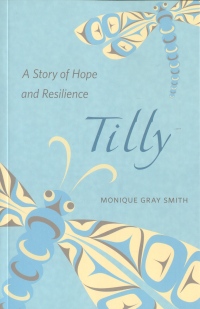| ________________
CM . . .
. Volume XX Number 6. . . .October 11, 2013 
 |
Tilly: A Story of Hope and Resilience.
Monique Gray Smith.
Winlaw, BC: Sono Nis Press, 2013.
207 pp., trade pbk., $19.95.
IBN 978-1-55039-209-8.
Grades 9-12 / Ages 14-17.
Review by Joan Marshall.
*** /4
|
| |
|

excerpt:
Without skipping a beat, he began his sales pitch. “I think you’ll really like Nelson. There’s a beautiful lake and lots to do for a girl your age.”
“I like Kamloops,” I said, my voice shaking.
“I know you do, but this is a good opportunity for me. For all of us.”
“It’s not good for me!” I jumped up, and the chair toppled to the floor. “Do you ever think of us? Huh, Dad, do you?” I stormed out of the kitchen and headed outside to find Mom in the garden.
She put her arm around me and pulled me closer. She knew there wasn’t much she could say that would help. “At least we’re not moving until the end of July, so you’ll get to finish off the school year here.”
“Whoopee. Big deal. Then what? We move to this town called Nelson. I bet they don’t even have field hockey or ball or anything I like.”
“We’ll just have to find a way to make the best of it,” Mom said. “I’ll have to give up my job at the hair salon, my curling team and my ceramics class. So it isn’t easy for me, either. But it’s a good opportunity for your dad.” She smiled at me, putting on a brave face. But I knew how she really felt.
Back in the house, I marched right past my dad and Marie and straight to the phone on the kitchen wall. I dialed Jo. Please be home, I said in my head.
She was, and I went over to hang out with her. Since her parents were out, we had free access to their liquor cabinet. Drinking was one way of escaping reality, and that afternoon escaping was all I wanted to do.
In this thinly disguised memoir, Aboriginal author Smith recounts her life journey as she copes with racism, the legacy of residential schools and alcoholism, supported by a loving powerful grandmother, an adoring auntie, a thoughtful concerned teacher, a patient persistent counsellor, a generous colleague and a loving committed husband. Various Aboriginal people she meets tell their life stories to her and allow her to highlight the pain of having your children taken away because of your drinking, the powerful effective message of AA, the pain of not belonging in the adopted white family, the on-the-land education of a traditional Aboriginal healer, the death of relationships and parenthood due to alcoholism, the 60’s Scoop of children and the personal tragedy of residential schools.
The main character, Tilly, begins drinking when she’s in her childhood to escape pain and loss. She manages to conceal her addiction for years, even graduating as a nurse. Finally, at the age of 23, she begins to deal with it, ending by entering a long, strict treatment centre based around discovering the strength of her Aboriginal ancestry and culture. She falls madly in love with Jessie whose charisma masks his lying, and she finally leaves him. Tilly focuses on her work as a nurse, on staying sober and on discovering how a traditional Aboriginal culture can help her to remain healthy. She meets and marries Mick, a Cree man from a strong, happy family. They give birth to twins, and Tilly continues her work for Aboriginal reconciliation and healing.
Tilly’s story is painful – a train wreck waiting to happen. You cover your eyes to escape the horror but slit them open again to see if she can sidestep the next crisis.
Although some of the dialogue is lively, even amusing, much of it “tells” the message as various counsellors and random people Tilly meets teach her the information she needs to start building sobriety or to create an understanding of native culture and injustices perpetrated on native people. The story is told in the first person which allows Tilly to share her emotions and innermost thoughts and struggles, but once again often slips into “telling”. The use of Aboriginal dialect adds a distinctive depth to the voices of many characters and should not deter understanding at all but rather draw the reader in.
Secondary characters, like Bea and Auntie Pauline, represent the powerful, calm, accepting native woman who is and will continue to be at the centre of Aboriginal renaissance in Canada. The men, from the duplicitous unrepentant Jessie to the apologetic committed Chuck, Saul and Dan, accurately reflect the monumental struggles native men are facing in the re-structuring of the Aboriginal community.
This book introduces themes that would generate much useful discussion in high school explorations of Aboriginal history and present-day activism. It would also serve well as a basis for the memoir vs creative nonfiction debate.
Recommended.
Joan Marshall is a Winnipeg, MB, bookseller.

To comment
on this title or this review, send mail to cm@umanitoba.ca.
Copyright © the Manitoba Library Association. Reproduction for personal
use is permitted only if this copyright notice is maintained. Any
other reproduction is prohibited without permission.
NEXT REVIEW |
TABLE OF CONTENTS FOR THIS ISSUE
- October 11, 2013.
AUTHORS |
TITLES |
MEDIA REVIEWS |
PROFILES |
BACK ISSUES |
SEARCH |
CMARCHIVE |
HOME |
